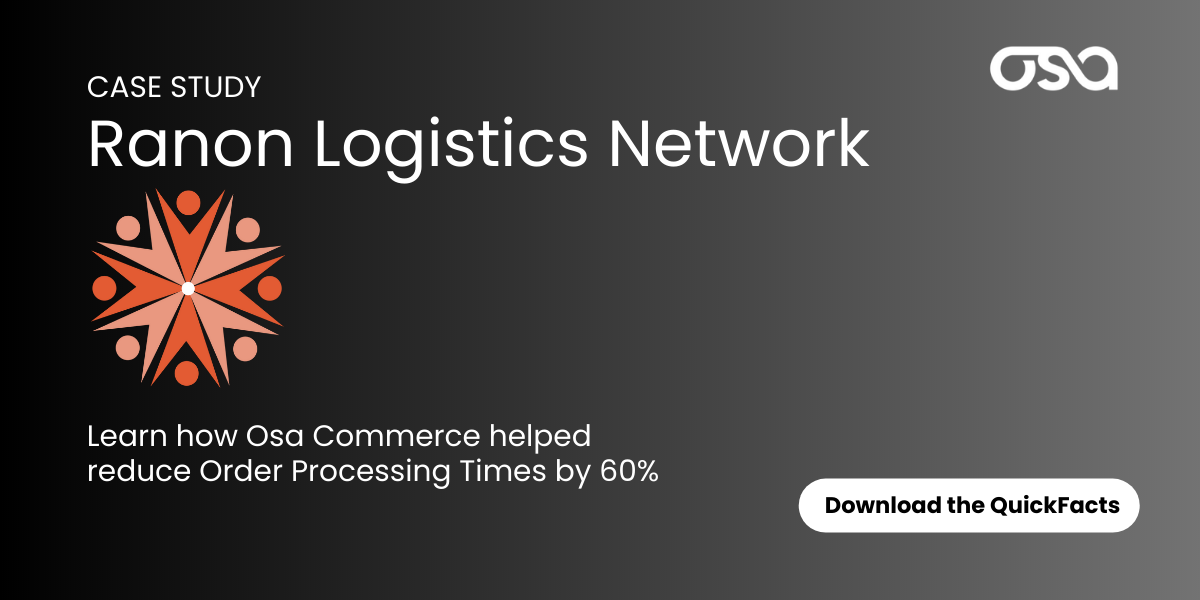3 min read
What Do Predictable Returns Mean for Brands and Their Customers?
![]() Osa Commerce
:
August 15, 2023
Osa Commerce
:
August 15, 2023
%20(1024%20%C3%97%20512%20px).png)
Delivering a seamless and delightful shopping experience for consumers remains a top priority for brands and retailers, especially in anticipation of this year's peak season. Robust and uncomplicated returns are a paramount part of holiday sales, considering that 17.9% of merchandise is returned, which equals $171 billion. One significant supply chain solution set to transform the industry is predictable returns technology. This innovative approach aims to revolutionize the way brands handle returns, providing both brands and consumers with a more efficient and satisfying experience. As a shopper myself, I prioritize easy returns when I’m buying online, and it looks like I’m not alone: over 60% of consumers will examine a return policy before buying a product. So, how can optimizing technology make the returns process better for both businesses and their loyal customers in time for peak season?
Understanding Predictable Returns Technology
Today’s consumers expect predictable services—from last-mile delivery services to returning unwanted products. To meet these demands, brands require predictable returns technology. By utilizing this data-driven and AI-powered approach, brands can anticipate and manage return processes more effectively. This type of supply chain technology leverages advanced data analytics, machine learning algorithms, and customer behavior insights, to help brands gain a comprehensive understanding of their consumers' buying preferences in addition to their return patterns. Armed with this knowledge, brands can take a proactive approach to optimize the return process, reduce return rates, and enhance customer satisfaction even in the peak season frenzy.
Brands and retailers who are investing in their returns technology should look for a collaborative visibility platform that connects their entire supply chain to further enhance operational efficiency. By seamlessly connecting data streams from disparate sources, collaborative visibility offers brands real-time insights. This technology not only informs brands of evolving consumer preferences and behaviors, but also presents an invaluable opportunity for proactive course correction. Brands, armed with this collective understanding, can pivot swiftly to align their strategies with emerging peak season trends, minimizing the factors that contribute to returns.
Enhanced Inventory Management
Predictable returns technology empowers brands to make data-driven decisions on inventory management. By analyzing return patterns and customer feedback, brands can identify products with higher return rates and address potential issues such as inaccurate product descriptions or sizing. This proactive approach enables brands to adjust inventory levels accordingly, reducing excess stock and improving supply chain efficiency.
Personalized Customer Experience
Through leveraging customer behavior data, brands can provide personalized recommendations to consumers based on their preferences and purchase history. By offering tailored product suggestions, brands can increase the chances of satisfying customers with their purchases, ultimately reducing the likelihood of returns and fostering brand loyalty. With 71% of customers wanting a personalized shopping experience, this aspect of returns technology is more important than ever.
Real-time Visibility
Forecasting technology offers real-time visibility into the return process, allowing brands to track returned items and their condition accurately. This level of transparency enhances communication with end consumers and builds trust, as customers can stay informed about the status of their returns.
One of the disadvantages of online shopping is complicated returns policies. With predictable software, brands and retailers can make the returns process convenient and hassle-free. Brands can offer pre-printed return labels, drop-off locations, or pick-up services, allowing customers to return products easily if necessary. Offering multiple ways for customers to return products is paramount. Given that 62% of consumers prefer the ability to return items in-store, providing multiple return channels becomes crucial for retaining and attracting peak season shoppers.
With advanced technology, brands can process returns more efficiently, leading to faster refunds or exchanges for customers. This timely resolution enhances the overall shopping experience and increases customer satisfaction.
Improved Product Quality
Having predictable returns allows brands to gain valuable insights into product quality and potential issues. By addressing these concerns promptly, brands can ensure that future products meet customer expectations, resulting in fewer returns due to defects.
Brands employing this supply chain technology can guarantee that product descriptions and sizing information are accurate and comprehensive. This clarity empowers consumers to make informed decisions, resulting in a higher likelihood of receiving products that match their expectations. This reduction in size-related returns cultivates a more positive shopping experience and more loyalty to the brand.
Predictable returns technology marks a significant leap forward for the retail industry in 2023 and is especially significant for logistics professionals navigating this year’s peak season. By leveraging data analytics and AI-powered solutions, brands can optimize their return processes, enhance inventory management, and provide personalized experiences for their end consumers. This technology benefits both brands and consumers by reducing operational costs, streamlining the return process, and fostering trust and loyalty. As brands and retailers continue to embrace and invest in new software technology, the future of e-commerce promises to be even more efficient, customer-centric, and successful.


